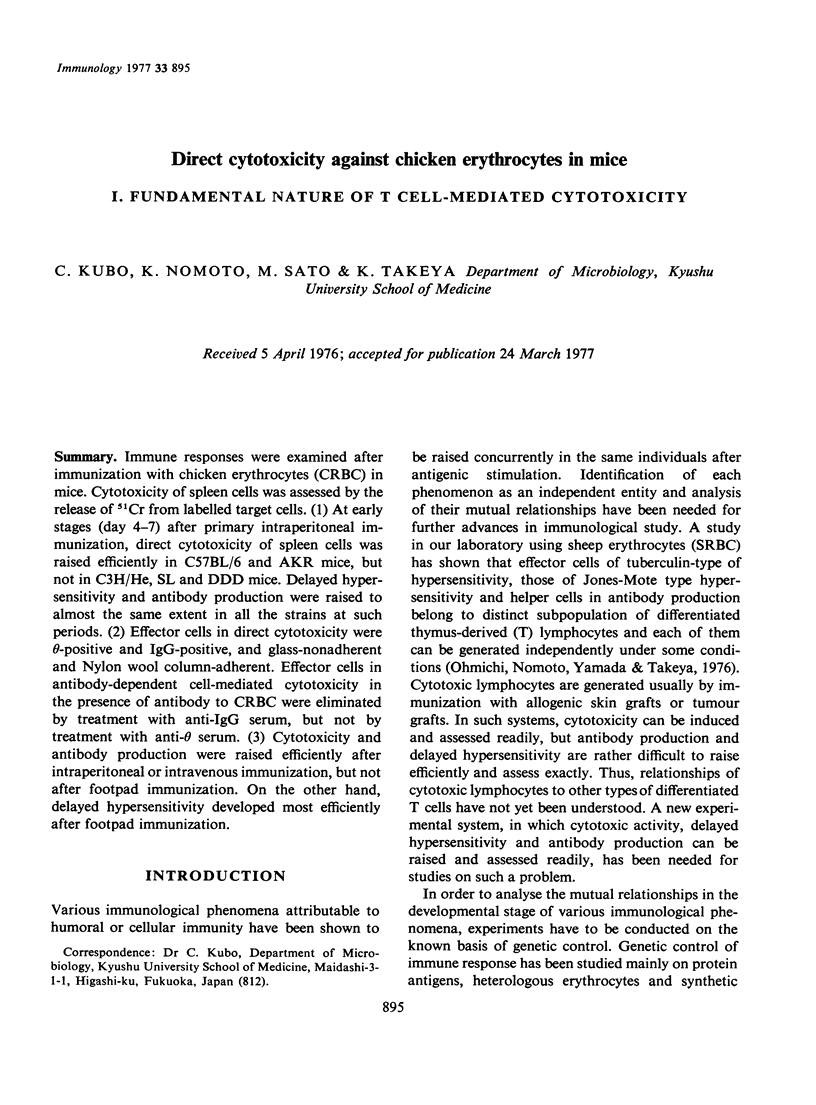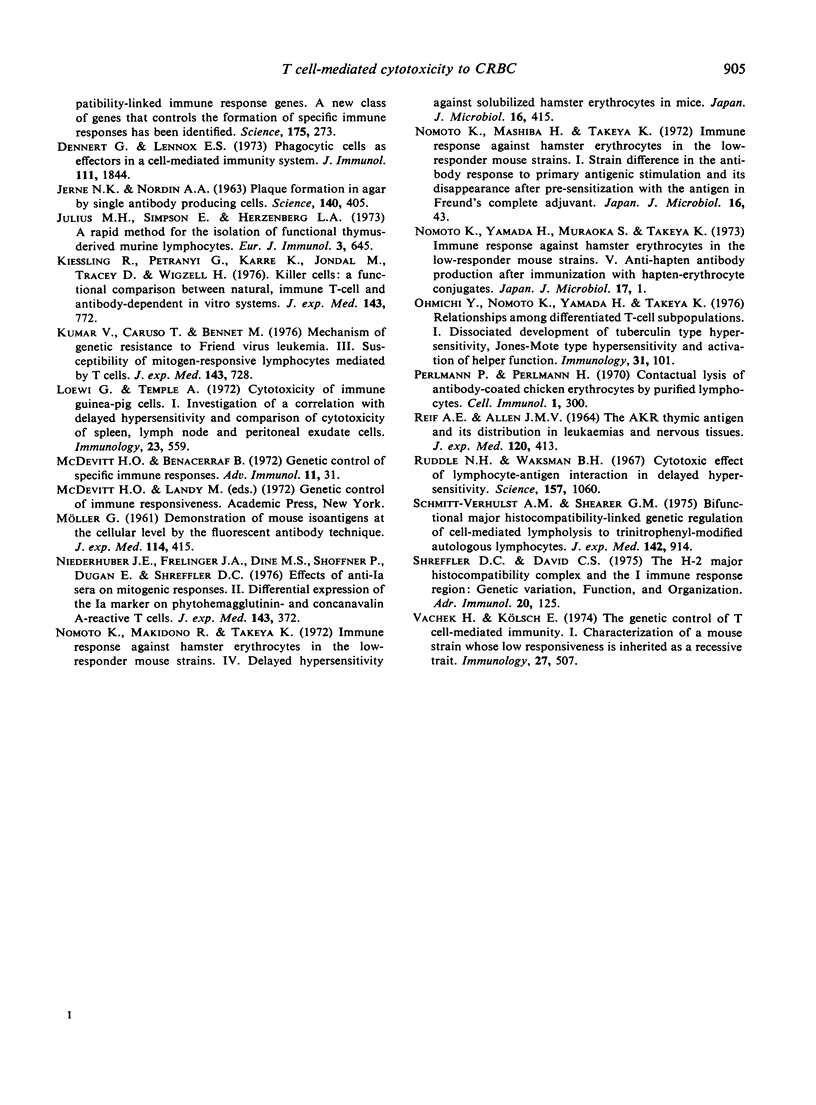Abstract
Immune responses were examined after immunization with chicken erythrocytes (CRBC) in mice. Cytotoxicity of spleen cells was assessed by the release of 51Cr from labelled target cells. (1) At early stages (day 4-7) after primary intraperitoneal immunization, direct cytotoxicity of spleen cells was raised efficiently in C57BL/6 and AKR mice, but not in C3H/He, SL and DDD mice. Delayed hypersensitivity and antibody production were raised to almost the same extent in all the strains at such periods. (2) Effector cells in direct cytotoxicity were theta-positive and IgG-positive, and glass-nonadherent and Nylon wool column-adherent. Effector cells in antibody-dependent cell-mediated cytotoxicity in the presence of antibody to CRBC were eliminated by treatment with anti-IgG serum, but not by treatment with anti-theta serum. (3) Cytotoxicity and antibody production were raised efficiently after intraperitoneal or intravenous immunization, but not after footpad immunization. On the other hand, delayed hypersensitivity developed most efficiently after footpad immunization.
Full text
PDF










Selected References
These references are in PubMed. This may not be the complete list of references from this article.
- Dennert G., Lennox E. S. Phagocytic cells as effectors in a cell-mediated immunity system. J Immunol. 1973 Dec;111(6):1844–1854. [PubMed] [Google Scholar]
- Jerne N. K., Nordin A. A. Plaque Formation in Agar by Single Antibody-Producing Cells. Science. 1963 Apr 26;140(3565):405–405. doi: 10.1126/science.140.3565.405. [DOI] [PubMed] [Google Scholar]
- Julius M. H., Simpson E., Herzenberg L. A. A rapid method for the isolation of functional thymus-derived murine lymphocytes. Eur J Immunol. 1973 Oct;3(10):645–649. doi: 10.1002/eji.1830031011. [DOI] [PubMed] [Google Scholar]
- Kiessling R., Petranyi G., Kärre K., Jondal M., Tracey D., Wigzell H. Killer cells: a functional comparison between natural, immune T-cell and antibody-dependent in vitro systems. J Exp Med. 1976 Apr 1;143(4):772–780. doi: 10.1084/jem.143.4.772. [DOI] [PMC free article] [PubMed] [Google Scholar]
- Kumar V., Caruso T., Bennett M. Mechanisms of genetic resistance to Friend virus leukemia. III. Susceptibility of mitogen-responsive lymphocytes mediated by T cells. J Exp Med. 1976 Apr 1;143(4):728–740. doi: 10.1084/jem.143.4.728. [DOI] [PMC free article] [PubMed] [Google Scholar]
- Loewi G., Temple A. Cytotoxicity of immune guinea-pig cells. I. Investigation of a correlation with delayed hypersensitivity and a comparison of cytotoxicity of spleen, lymph node and peritoneal exudate cells. Immunology. 1972 Oct;23(4):559–567. [PMC free article] [PubMed] [Google Scholar]
- McDevitt H. O., Benacerraf B. Genetic control of specific immune responses. Adv Immunol. 1969;11:31–74. doi: 10.1016/s0065-2776(08)60477-0. [DOI] [PubMed] [Google Scholar]
- Niederhuber J. E., Frelinger J. A., Dine M. S., Shoffner P., Dugan E., Shreffler D. C. Effects of anti-Ia sera on mitogenic responses. II. Differential expression of the Ia marker on phytohemagglutinin and concanavalin A-reactive T cells. J Exp Med. 1976 Feb 1;143(2):372–381. doi: 10.1084/jem.143.2.372. [DOI] [PMC free article] [PubMed] [Google Scholar]
- Nomoto K., Makidono R., Takeya K. Immune response against hamster erythrocytes in the low-responder mouse strains. IV. Delayed hypersensitivity against solubilized hamster erythrocytes in mice. Jpn J Microbiol. 1972 Sep;16(5):415–423. doi: 10.1111/j.1348-0421.1972.tb00676.x. [DOI] [PubMed] [Google Scholar]
- Nomoto K., Mashiba H., Takeya K. Immune response against hamster erythrocytes in the low-responder mouse strains. I. Strain difference in the antibody response to primary antigenic stimulation and its disappearance after pre-sensitization with the antigen in Freund's complete adjuvant. Jpn J Microbiol. 1972 Jan;16(1):43–51. doi: 10.1111/j.1348-0421.1972.tb00626.x. [DOI] [PubMed] [Google Scholar]
- Nomoto K., Yamada H., Muraoka S., Takeya K. Immune response against hamster erythrocytes in the low-responder mouse strains. V. Anti-hapten antibody production after immunization with hapen-erythrocyte conjugates. Jpn J Microbiol. 1973 Jan;17(1):1–5. doi: 10.1111/j.1348-0421.1973.tb00696.x. [DOI] [PubMed] [Google Scholar]
- Ohmichi Y., Nomoto K., Yamada H., Takeya K. Relationships among differentiated T-cell subpopulations. I. Dissociated development of tuberculin type hypersensitivity, Jones-Mote type hypersensitivity and activation of helper function. Immunology. 1976 Jul;31(1):101–110. [PMC free article] [PubMed] [Google Scholar]
- Perlmann P., Perlmann H. Contactual lysis of antibody-coated chicken erythrocytes by purified lymphocytes. Cell Immunol. 1970 Sep;1(3):300–315. doi: 10.1016/0008-8749(70)90051-1. [DOI] [PubMed] [Google Scholar]
- REIF A. E., ALLEN J. M. THE AKR THYMIC ANTIGEN AND ITS DISTRIBUTION IN LEUKEMIAS AND NERVOUS TISSUES. J Exp Med. 1964 Sep 1;120:413–433. doi: 10.1084/jem.120.3.413. [DOI] [PMC free article] [PubMed] [Google Scholar]
- Ruddle N. H., Waksman B. H. Cytotoxic effect of lymphocyte-antigen interaction in delayed hypersensitivity. Science. 1967 Sep 1;157(3792):1060–1062. doi: 10.1126/science.157.3792.1060. [DOI] [PubMed] [Google Scholar]
- Schmitt-Verhulst A. M., Shearer G. M. Bifunctional major histocompatibility-linked genetic regulation of cell-mediated lympholysis to trinitrophenyl-modified autologous lymphocytes. J Exp Med. 1975 Oct 1;142(4):914–927. doi: 10.1084/jem.142.4.914. [DOI] [PMC free article] [PubMed] [Google Scholar]
- Shreffler D. C., David C. S. The H-2 major histocompatibility complex and the I immune response region: genetic variation, function, and organization. Adv Immunol. 1975;20:125–195. doi: 10.1016/s0065-2776(08)60208-4. [DOI] [PubMed] [Google Scholar]
- Vachek H., Kölsch E. The genetic control of T cell-meditated immunity. I. Characterization of a mouse strain whose low responsiveness is inherited as a recessive trait. Immunology. 1974 Oct;27(4):507–515. [PMC free article] [PubMed] [Google Scholar]


